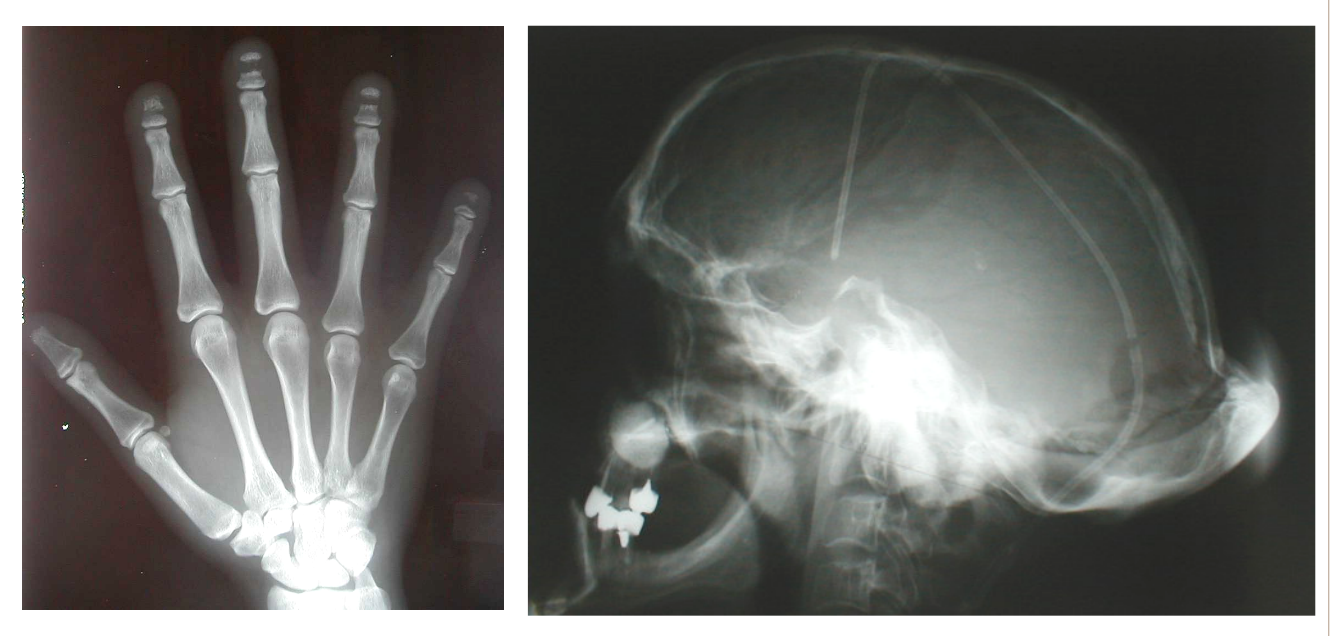Hajdu–Cheney syndrome
Editor-In-Chief: Prab R Tumpati, MD
Obesity, Sleep & Internal medicine
Founder, WikiMD Wellnesspedia &
W8MD medical weight loss NYC and sleep center NYC
| Hajdu–Cheney syndrome | |
|---|---|

| |
| Synonyms | Acroosteolysis dominant type, arthrodentoosteodysplasia |
| Pronounce | |
| Specialty | Medical genetics |
| Symptoms | Acro-osteolysis, short stature, craniofacial dysmorphism, dental anomalies, osteoporosis |
| Complications | N/A |
| Onset | Childhood |
| Duration | Lifelong |
| Types | N/A |
| Causes | Genetic mutation in the NOTCH2 gene |
| Risks | |
| Diagnosis | Clinical examination, genetic testing |
| Differential diagnosis | Pycnodysostosis, Hajdu-Cheney syndrome |
| Prevention | N/A |
| Treatment | Supportive care, orthopedic surgery, dental care |
| Medication | Bisphosphonates |
| Prognosis | N/A |
| Frequency | Rare, less than 100 cases reported |
| Deaths | |
Hajdu–Cheney syndrome is a rare, autosomal dominant, congenital disorder characterized by severe and progressive bone loss. The most common symptoms include craniofacial anomalies, short stature, and acro-osteolysis (resorption of the distal phalanges). The syndrome is also associated with cardiovascular issues, such as valvular heart disease and aneurysms.
Signs and Symptoms[edit | edit source]
Hajdu–Cheney syndrome presents with a variety of symptoms, the most common of which are craniofacial anomalies, short stature, and acro-osteolysis. Other symptoms may include:
- Platybasia (flattening of the skull base)
- Wormian bones (extra bone pieces within the sutures of the skull)
- Micrognathia (undersized jaw)
- Dental anomalies
- Hearing loss
- Short stature
- Joint laxity and hypermobility
- Osteoporosis and fractures
- Cardiovascular disease, including valvular heart disease and aneurysms
Causes[edit | edit source]
Hajdu–Cheney syndrome is caused by mutations in the NOTCH2 gene. This gene provides instructions for making a protein that helps control the development and function of many types of cells, including those involved in bone formation.
Diagnosis[edit | edit source]
Diagnosis of Hajdu–Cheney syndrome is based on clinical evaluation, detailed patient history, identification of characteristic symptoms, and a variety of specialized tests. These tests may include X-rays, CT scan, MRI, and genetic testing.
Treatment[edit | edit source]
There is no cure for Hajdu–Cheney syndrome. Treatment is symptomatic and supportive, and may include physical therapy, pain management, and surgical interventions for severe bone deformities.
Prognosis[edit | edit source]
The prognosis for individuals with Hajdu–Cheney syndrome varies. Some individuals have a normal lifespan with mild symptoms, while others may have severe complications such as spinal cord compression and heart disease.
See Also[edit | edit source]
References[edit | edit source]
Search WikiMD
Ad.Tired of being Overweight? Try W8MD's physician weight loss program.
Semaglutide (Ozempic / Wegovy and Tirzepatide (Mounjaro / Zepbound) available.
Advertise on WikiMD
|
WikiMD's Wellness Encyclopedia |
| Let Food Be Thy Medicine Medicine Thy Food - Hippocrates |
Translate this page: - East Asian
中文,
日本,
한국어,
South Asian
हिन्दी,
தமிழ்,
తెలుగు,
Urdu,
ಕನ್ನಡ,
Southeast Asian
Indonesian,
Vietnamese,
Thai,
မြန်မာဘာသာ,
বাংলা
European
español,
Deutsch,
français,
Greek,
português do Brasil,
polski,
română,
русский,
Nederlands,
norsk,
svenska,
suomi,
Italian
Middle Eastern & African
عربى,
Turkish,
Persian,
Hebrew,
Afrikaans,
isiZulu,
Kiswahili,
Other
Bulgarian,
Hungarian,
Czech,
Swedish,
മലയാളം,
मराठी,
ਪੰਜਾਬੀ,
ગુજરાતી,
Portuguese,
Ukrainian
Medical Disclaimer: WikiMD is not a substitute for professional medical advice. The information on WikiMD is provided as an information resource only, may be incorrect, outdated or misleading, and is not to be used or relied on for any diagnostic or treatment purposes. Please consult your health care provider before making any healthcare decisions or for guidance about a specific medical condition. WikiMD expressly disclaims responsibility, and shall have no liability, for any damages, loss, injury, or liability whatsoever suffered as a result of your reliance on the information contained in this site. By visiting this site you agree to the foregoing terms and conditions, which may from time to time be changed or supplemented by WikiMD. If you do not agree to the foregoing terms and conditions, you should not enter or use this site. See full disclaimer.
Credits:Most images are courtesy of Wikimedia commons, and templates, categories Wikipedia, licensed under CC BY SA or similar.
Contributors: Prab R. Tumpati, MD


